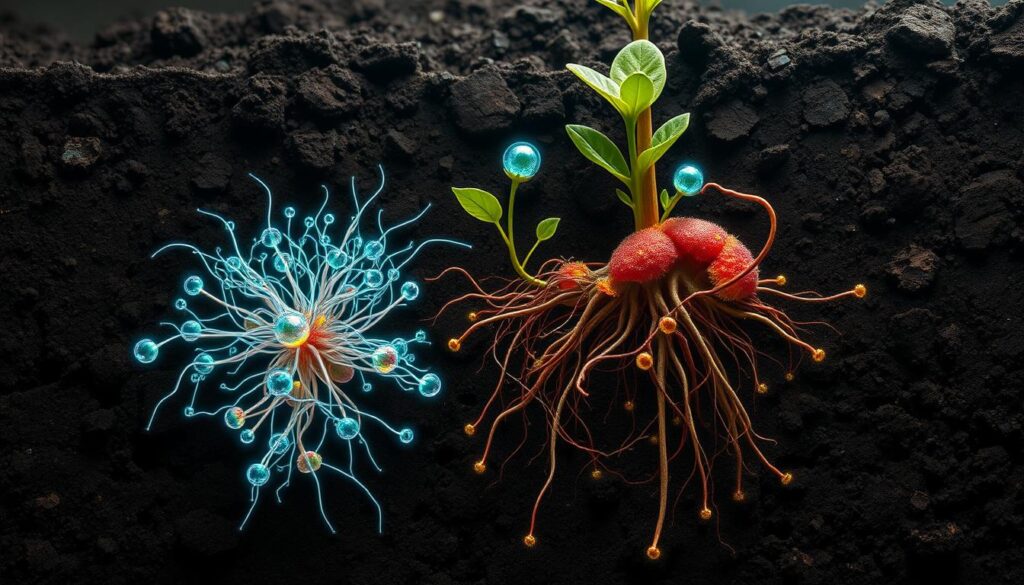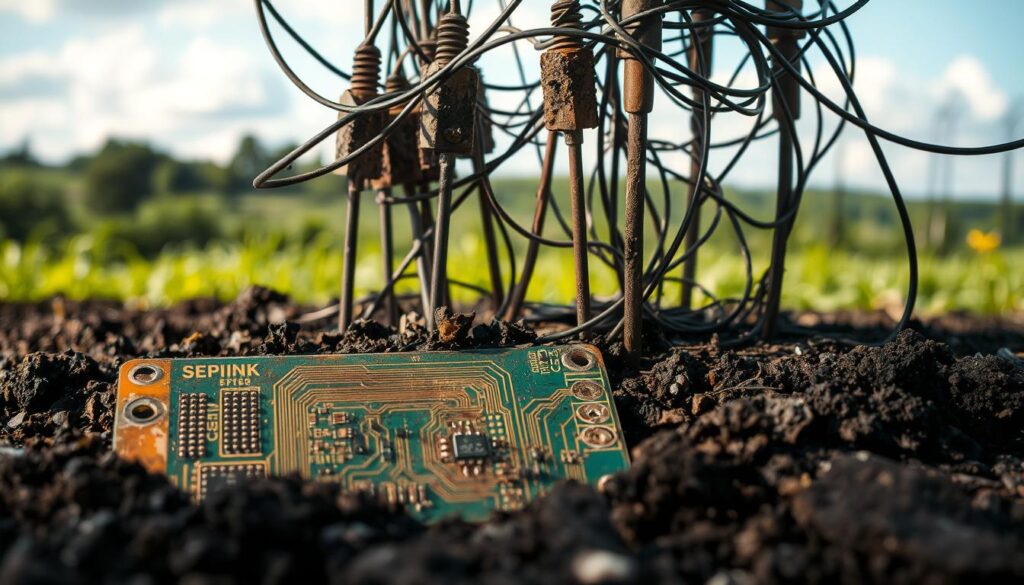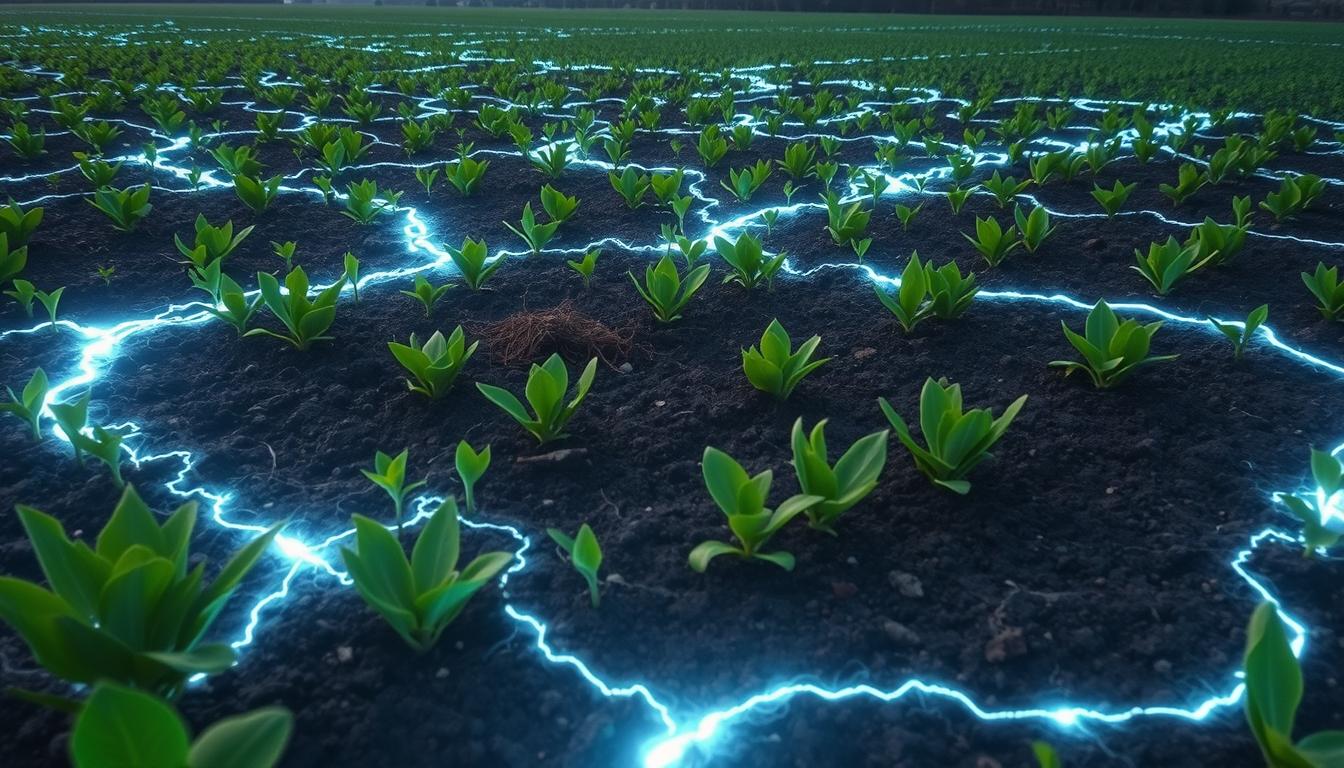Imagine powering farms with the earth itself. Researchers are unlocking nature’s hidden potential by tapping into tiny electrical currents found in the ground. These breakthroughs could change how we grow food.
Northwestern University created a paperback-sized device that generates power from microbial activity. Meanwhile, Linköping University boosted barley growth by 50% using special conductive materials. This isn’t just lab work—companies like Lebone Solutions already light up African villages using similar tech.
These innovations tackle big challenges. They help crops use water better and grow faster. For farmers and eco-conscious growers, this means healthier plants with less waste. The science behind it blends biology and smart engineering for real-world impact.
Key Takeaways
- Microbes in the ground create usable energy for farming tech
- New studies show crops grow up to 50% faster with electrical help
- Affordable devices now bring this tech to rural areas
- Better water use and stronger plants are major benefits
- This approach combines nature with modern agriculture tools
What Is Soil Electricity?
The ground beneath our feet holds more than just nutrients—it pulses with hidden energy. Tiny organisms and chemical reactions create currents that plants might use to thrive. This isn’t sci-fi; it’s a natural process scientists are learning to harness.
The Science Behind Electrical Currents in Soil
Certain bacteria, like Shewanella and Geobacter, act as living wires. They break down organic matter, releasing electrons as waste. These electrons travel through the ground, creating a faint but measurable current.

In nature, this flow is slow. But with human help, it can power devices. A microbial fuel cell (MFC) speeds things up. It uses:
- An anode to collect electrons from bacteria
- A cathode exposed to oxygen
- A wire connecting them to complete the circuit
How Microbes Generate Electricity in Soil
Think of bacteria as chefs. They “eat” decaying plants, “exhaling” electrons instead of carbon dioxide. These electrons hop onto the anode, then zip through a wire to the cathode—just like a battery.
| Feature | Natural Currents | Enhanced Systems |
|---|---|---|
| Power Source | Random bacterial activity | Optimized anode/cathode setup |
| Output | Microscopic | Enough for LED lights |
| Example | Forest floors | Lebone’s village lights |
Companies like Lebone Solutions use graphite cloth anodes and chicken wire cathodes. Moisture keeps the system conductive, proving even simple materials can unlock nature’s power.
The Role of Soil Electricity in Modern Agriculture
What if farms could grow stronger crops with less water and fewer chemicals? Researchers at Linköping University turned this idea into reality with a breakthrough material called eSoil. This biodegradable blend of cellulose and conductive PEDOT polymer is rewriting the rules of plant care.

Supercharging Nutrient Uptake
Electrified barley seedlings in the study processed nitrogen 50% more efficiently. The secret? Tiny currents stimulate root systems, acting like a turbocharger for nutrient absorption.
“It’s like giving plants a caffeine boost for their metabolic processes,”
explains one researcher.
Key advantages of eSoil:
- Water savings: Hydroponic systems using it require 90% less water.
- Faster growth: Barley showed dramatic biomass increases in just 15 days.
- Less fertilizer: Optimized uptake reduces chemical dependency.
From Lab to Urban Farms
The implications stretch beyond traditional fields. Vertical farms could slash resource use while boosting yields. Early tests suggest protein synthesis in plants improves too—a potential game-changer for drought-resistant crops.
Yet mysteries remain. Scientists are still decoding how exactly electrical cues affect plant biology. One thing’s clear: merging nature’s wisdom with human innovation could redefine sustainable agriculture.
Innovative Technologies Using Soil Electricity
The future of farming may lie in tiny currents beneath our feet. Engineers are creating smart systems that turn microbial activity into usable power. These breakthroughs help farmers monitor crops while reducing resource waste.
Microbial Fuel Cells: Powering Sensors and Devices
Northwestern University redesigned the classic fuel cell for tough field conditions. Their vertical cathode works even when soil moisture is just 41%. This flood-resistant design uses air gaps for continuous oxygen access.
The secret lies in the electrode setup. Bacteria cluster on carbon cloth, while a simple wire completes the circuit. These cells generate enough energy to run wireless sensors for months.

Lebone Solutions: Lighting Up Rural Africa
This social enterprise proves the technology works at scale. Their 5m² systems power LED lamps and small fans using 53.8W outputs. Villages get light without expensive infrastructure.
The real win? Hardware store components. Chicken wire cathodes and graphite anodes make these solutions affordable. Farmers can monitor soil data through simple IoT integrations.
Commercial systems now outperform lab prototypes. Lebone’s design delivers 68x more power than early models. Maintenance-free operation makes it ideal for remote areas.
Future versions might use conductive material blends for better performance. As costs drop, US farms could adopt these systems within 3-5 years.
Benefits of Soil Electricity for Sustainable Farming
Farmers are discovering a game-changing way to boost harvests while saving resources. By harnessing natural currents, they’re cutting costs and improving yields—all with eco-friendly tech.

Reducing Water and Resource Consumption
Electrified hydroponic systems reuse 95% of irrigation water, a stark contrast to traditional methods. Closed-loop designs deliver nutrients precisely where roots need them, minimizing waste.
Key advantages:
- Energy efficiency: eSoil production uses 60% less energy than mineral wool.
- Chemical reduction: Continuous monitoring prevents over-fertilization, protecting waterways.
- Climate resilience: Steady currents help retain moisture during droughts.
Improving Soil Health and Crop Yields
Microbial activity thrives under controlled currents, increasing organic matter retention by up to 30%. Healthier dirt means stronger plants—studies show corn and soybean yields up 20% in trials.
Long-term benefits include:
- Natural carbon sequestration through enhanced microbial networks.
- Reduced chemical runoff, improving food safety.
- Lower input costs for farmers in arid areas.
“This isn’t just about bigger harvests—it’s about rebuilding our relationship with the land.”
Challenges and Limitations of Soil Electricity
While soil electricity shows promise, several hurdles must be overcome for widespread use. Current systems face technical barriers that limit their real-world impact, especially for large operations.

Power and Performance Constraints
The biggest hurdle? Power output. Today’s microbial fuel cells generate just 0.21mW—less than 1% of a lithium battery’s capacity. This restricts applications to small sensors rather than farm equipment.
Field conditions create additional issues:
- Electrode materials degrade faster outdoors
- Temperature swings affect microbial activity
- Energy storage remains unreliable for continuous use
Scaling Up Agricultural Applications
Adoption faces practical challenges too. Only 12% of US farmers use precision agriculture tech, suggesting slow acceptance of new methods. Commercial integration may take 5+ years.
Key scalability factors include:
- High upfront costs for large fields
- Training requirements for farm crews
- Regulatory approval for electrical soil treatments
“We’re bridging biology and engineering—but the learning curve is steep for both sides.”
Hybrid systems combining this tech with solar may offer solutions. Ongoing research focuses on improving power output while reducing maintenance needs.
Conclusion: The Future of Soil Electricity in Agriculture
From rural villages to Mars colonies, bioelectric farming is gaining traction. NASA’s experiments with sustainable practices for extraterrestrial crops hint at its potential, while the USDA’s 2026 roadmap prioritizes bioelectrical solutions for food security.
Upcoming technology integrates with 5G networks and AI-driven current dosing, optimizing growth in urban farming and drought-prone areas. Community microgrids could democratize access, turning farms into energy hubs.
Ethical debates continue, but one truth stands: these innovations buffer against climate change. Start small—try a DIY soil battery. The future of agriculture isn’t just greener; it’s charged with possibility.

